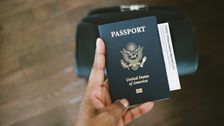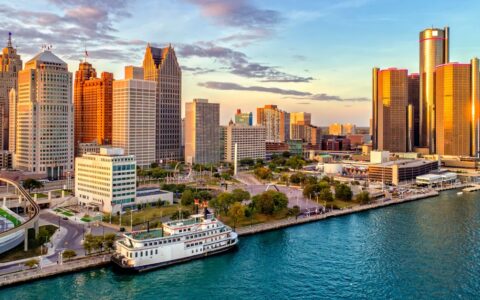
Our passport photos are rarely the most flattering pictures we have of ourselves. That drugstore or post office lighting is not ideal, and it doesn’t help that we don’t get to show off our best happy faces.
When the time came to renew my passport last year, I received strict instructions from the postal worker who took my new photo that I must not smile. The resulting picture was … joyless, to say the least.
But why exactly aren’t people allowed to smile in their passport photos the way we do in other pictures? The answer has to do with technology and international security.
Why Smiling Is Frowned Upon
The United States doesn’t officially ban smiling. Rather, the State Department requires that passport photos show “a neutral facial expression with both eyes open and mouth closed.” The subject must look straight ahead and directly face the camera as well.
“An applicant actually can smile in their passport photo, as long as both of their eyes are open and their mouth is closed in the photo,” a spokesperson for the department told HuffPost.
So if you’d like to look a little more upbeat in your passport photo, perhaps the solution is to opt for a Tyra Banks-style “smize.” Showing your teeth won’t pass muster ― and apparently it’s a matter of border security.
“The main reason for banning smiling is the introduction of facial recognition software at airports and other border control checkpoints,” said Karolina Turowska, a biometric photography and travel expert at Passport-Photo.Online.
Many ports of entry utilize computers rather than immigration officers to scan arriving travelers’ passports and photograph them. Although humans can recognize each other easily regardless of facial expression, machines need a little extra help.
“Algorithms don’t work as we do,” Turowska explained. “To compare a 3D face with a 2D passport photo, they need to pinpoint and measure the users’ facial features. It includes the distance between the pupils, ears, nose and mouth, the mouth’s and the eyes’ width, and many others. Smiling can make it harder, as it alters facial proportions.”
Katy Nastro, a travel expert and spokesperson for the flight alert service Going, emphasized that the State Department rules don’t ban smiling explicitly.
“It moreso means you can’t smile like you’re posing for the first day of school, pearly whites front and center,” she said. “Smiling wide with teeth makes it harder to verify eye color and general face shape by passport officials ― namely biometric technology ― who need to confirm your identity. With a majority of places using facial recognition technology at border controls, this is even more important as current biometric tech often has a hard time if points on the face are shifted.”
Not Just An American Rule
“Avoiding smiling in passport photos is a universal rule for most countries,” Turowska said. “Although, the way different countries define a ‘neutral facial expression’ can vary as they use other face recognition software. For example, official French requirements don’t allow even neutral expressions with the corners of the mouth turned up.”
The State Department spokesperson noted that The International Civil Aviation Organization “sets global standards and recommended practices for travel documents.” This includes guidelines for facial expressions in passport photos.
“Photos with exaggerated expressions can make it more difficult to readily identify the passport holder,” he explained, noting that the agency’s photo requirements have “been in effect for United States passports for decades.”
Indeed, the U.S. and other countries updated their rules around facial expressions in 2004 as the technology evolved.
“The face has always been the standard for biometric identification by the International Civil Aviation Organization, but because computers are limited in specific facial recognition capabilities, a neutral expression was deemed the gold standard,” Nastro said.
But these kinds of rules are still relatively new in the grand scheme of things. The idea for the internationally standardized passport system we use today dates back to 1920 in the aftermath of World War I.
“Passport photos weren’t always as strict as they are today,” said Madison Blancaflor, a senior editor at The Points Guy. “When passport photos first started to be used, there were very limited ― if any ― regulations to what the photos included. You can find some very interesting historical examples online of old passports with people playing instruments or wearing distracting hats. However, over the years more regulations have been put into place to heighten security efforts.”
What Happens If You Submit A Smiling Photo
“The most common reason for a passport processing delay is improper photos,” Nastro noted. “Even the best of smiles can get turned down for not meeting requirements set forth on the state department website. It’s best to not risk it and take a photo with a neutral expression, especially if you want it processed as quickly as possible.”
If you decide to smile widely and show off your pearly whites in your photo, the passport agency will delay your application and request a new photo in keeping with the stated requirements, the State Department spokesperson noted.
Should this happen to you, you’ll receive a letter and/or email with instructions for resubmitting an acceptable photo.
“If you’re unable to provide a photo that meets their standards by the deadline given, your passport application may remain in ‘on hold’ limbo forever or be rejected,” Blancaflor warned.
The State Department’s guidelines also forbid eyeglasses unless they cannot be removed for medical reasons ― in which case you must submit a signed statement from your doctor with your passport application. Hats or head coverings are a no-go unless they are “part of traditional religious attire worn continuously in public,” which also would require a signed statement attesting to this fact.
“Not only is smiling prohibited: Applicants cannot tighten their mouths, frown or crinkle,” Turowska added.
Refer to the State Department website for other rules regarding lighting, retouching, background and other aspects.
“The stringent rule regarding smiling is somewhat more lenient for children since having them maintain a neutral facial expression is challenging,” Turowska noted. “The smile cannot impair the recognition of their facial features; however, as long as the child faces the camera and has his eyes open, the passport authorities should accept a smiling photo.”
Source link
CHECK OUT: Top Travel Destinations
READ MORE: Travel News



